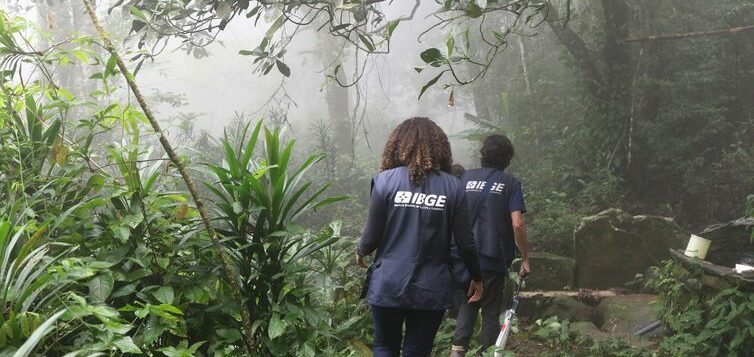In the middle of a dense area of Atlantic Forest, the fine drizzle forms a mist. The temperature is considerably lower than in the built-up neighborhoods of Rio de Janeiro. Around a rich breakfast table enriched with local products, people get closer. The team of census takers from the Brazilian Institute of Geography and Statistics (IBGE) begins the first interviews of a journey that would last until mid-afternoon.

ADVERTISING
At lunch, full feijoada was served. At the end of the work, emotional and with a choked voice, Eulália Ferreira da Silva read a text with thanks and tributes.
It wasn't just any day. A unprecedented visit by the IBGE team was seen as a historic moment by residents of the quilombola community of Pedra Bonita. The report from Agency Brazil, who asked for permission to follow the work, was also surprised with a tribute. The quilombolas handed over a plaque thanking them “for the noble work of documenting the first census in the history of these families, providing historical knowledge that links journalistic memory and national memory”. (Folha de S.Paulo)
“In official data and records, we have not existed in more than 150 years. That's why it's such an important and historic date. We are being recognized as Brazilian citizens”, said Eulália, 61 years old. “We have been forgotten for centuries. They cannot make us invisible and hide a history that is notorious and that we have recorded in old photos and documents.”/
ADVERTISING
- Two-year delay in data collection
Brazil usually carries out the Demographic Census every ten years. It is the only household survey that covers all 5.570 municipalities in the country. The objective is to offer a portrait of the population and household conditions in the country. The information obtained supports the development of public policies and decisions related to the allocation of financial resources. The census, which should have been carried out in 2020, was postponed twice: first, due to the Covid-19 pandemic and then due to budgetary difficulties.
- Census 2022 has new delays
The census operation started in June this year. The work, initially expected to be completed in October, is behind schedule: with 49% of the population covered, IBGE now estimates that the census extends until the beginning of December.
The forecast is to visit 5.972 quilombola locations. And the first time that this population is being consulted. In the 2010 edition, IBGE included a record of indigenous ethnicities.
ADVERTISING
Participation of quilombolas: cultural richness and specific recommendations
There is specific preparation for the task of collecting data from these populations for the first time, says Isabela Nery Lima, economist and census analyst at IBGE who is in charge of coordinating information collection on traditional peoples.
“We need to do all of this in the least invasive way possible. And that's why we look for leaders. They act as partners who help open the doors and also guide us around the territory so we can interview all the residents”, says Isabela. “It is the recognition of people who need to be part of social processes, the political process. It is, in fact, even a way of combating historical erasure.”
The inclusion of quilombolas, according to the expert, gives Brazil the opportunity to discover your own diversity, allowing better territorial planning and the creation of new public policies.
ADVERTISING
Pedra Bonita Quilombola Community
- In Pedra Bonita, 50 people live in 20 residences, some of which are considerably dilapidated. According to residents, environmental inspection agents have prevented renovations.
- Another 60 quilombola communities within the state of Rio de Janeiro will receive visits from IBGE census takers.
The history of the quilombola community of Pedra Bonita is an example. Located in the Tijuca National Park. Despite officially belonging to the territory of the capital of Rio, the community had never received a visit from census takers. Nearby is the free flight ramp, from where tourists and extreme sports enthusiasts hang gliding or paragliding to enjoy a unique view of the capital of Rio de Janeiro before landing at Praia de São Conrado.
There began to gather, from the 1860s onwards, not only former black slaves, but also indigenous people and immigrants poor Portuguese who joined the abolitionist cause. Occupying three farms, these people supported themselves by producing vegetables and fruits and the cultivation of flowers ornamental. It is estimated that there are more than 2 thousand camellia trees, a flower that was adopted as a symbol of the Abolitionist Confederation, a political organization that emerged in Rio de Janeiro in 1883 and fought for the end of slavery.
Sentimental value and preservation

A descendant of former slaves and indigenous people, Jose Emílio Cordeiro, aged 53, is today the president of the Association of Traditional and Quilombola Population of Pedra Bonita (Aquibonita), founded by the community's residents. He says that his first relatives, as well as other families, arrived at the place when the government promoted the reforestation of the area between 1860 and 1890.
“Many came to work almost obligated. Here was a place where they hid because everyone, in a certain way, was discriminated against. And they formed this community that defends the forest. We are preservers by nature, not because of fads. It is our origin. Every little plant, every tree here for us has the hand of our ancestors and has enormous meaning.”
ADVERTISING
The unprecedented visit of the census takers was celebrated by José Emílio:
“It is a victory for all quilombos, but specifically for us, it is a great victory considering the external threats we suffer. We need help from public authorities. And IBGE helps us show this land, not for its commercial value, but for its sentimental value. It’s the story of our ancestors and the story of all this vegetation.”
He highlights, however, that some of the biggest challenges for those who live in the middle of the forest are the difficulty of access to electrical energy, which prevents families from having, for example, a refrigerator. According to him, it is also difficult to access public health and education services.
During the pandemic of Covid-19, the vaccination of quilombolas was considered a priority by the National Immunization Plan (PNI), but no agent was in the Pedra Bonita community, and residents had to travel to the nearest clinics in the neighborhoods of Alto da Boa Vista and São Conrado and were attended to according to the calendar of the general population.
Fight for territory
The Tijuca National Park was created in 1961 without land regularization of the area occupied by families. The community was threatened with eviction at different times and, only in June last year, it was recognized as a quilombola remnant, receiving the certificate from the Palmares Foundation, linked to the Ministry of Citizenship. O land titling process is being processed at the National Institute of Colonization and Agrarian Reform (Incra).
José Emílio reports that “it is a constant struggle” to defend the territory in which he lives today.
“We resist because it has, for us, emotional value. But people want to get money out of here. There have already been, for example, discussions about building a hotel here. And some environmentalists are influenced. We know that. So we became the guardians of that here,” he says. “It is the State itself acting against those in place and erasing history.”
“But we also know that management changes and there are always external influences that are not always interested in preservation. There was a National Park administration that gave us a diploma and recognized our role as guardian of the forest, but there was also a manager saying that we are invaders. Without a doubt, this preserved environment is due to our families. We know that there are laws that protect us, but unfortunately we need to fight to apply and protect the law”, adds the resident.
With information from Agency Brazil




